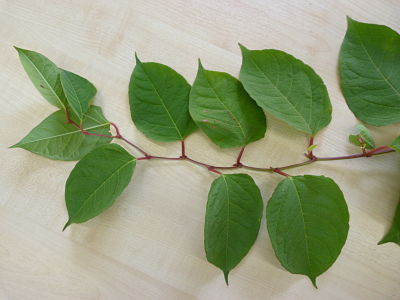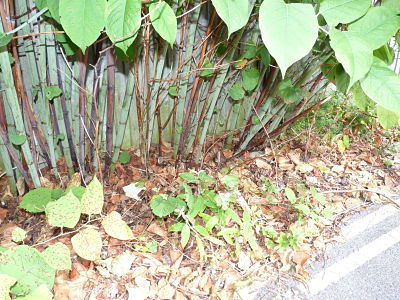
A plant which can damage hard surfaces such as tarmac, grow through the floors of houses, occasionally even through the foundations, and by its vigorous growth can exclude almost all of our native species.
Identifying the problemJapanese Knotweed (scientific name Fallopia Japonica) was introduced from Asia to Europe, including the UK, in the mid-nineteenth century, primarily as an ornamental plant. In fact, it is a highly invasive perennial weed, which grows to a height of up to 3m, and comprises Bamboo-like stems with a purple speckled appearance. Dense areas of tall canes grow during summer and then die back in the autumn. Creamy white flowers appear late in the season. Once present at a site, Japanese Knotweed grows quickly if left unchecked to cover large areas. During later autumn/winter the canes lose their leaves and turn dark brown. The dead canes remain standing and can then take up to three years to decompose. This dead material often forms a dense organic layer, which suppresses competition from our native flora and garden plants.
In the UK the reproduction of Japanese Knotweed is mainly through vegetative regeneration of rhizomes and fresh stems. The rhizome is a root-like underground stem, which can reach a depth of 3m and extend up to 7m away from the parent plant. Sections of rhizomes as small as 0.7g can grow into new plants! In the same way that poppies appear on sites, Japanese Knotweed thrives on disturbance. Fragments of the plant can be dispersed on high water flows resulting in its growth on the banks of waterways where it chokes the riverbank. Fly tipping and transportation of soil containing rhizome fragments are now seen as a major cause of spread, particularly in urban areas.

Japanese Knotweed is not an easy plant to control. Unfortunately, the extensive underground rhizome system sustains the plant even when growth above ground is removed. Therefore, the aim of any control programme must be to target the rhizomes. One way of achieving this is the use of chemical treatments, for example, herbicides such as glyphosate. The use of such chemicals can require consents from the Environment Agency, particularly in areas where there may be a risk of run-off to water courses, or where there is adjacent sensitive vegetation. Treatment can take several years before the plant is completely eradicated and, during this period, continuous monitoring is necessary to check that no new shoots appear. In controlling Japanese Knotweed you need to remember that it regenerates vegetatively. Very small fragments of rhizome and fresh stem material are able to produce viable shoots and roots. It is now an offence in the UK to cause this plant to grow in the wild under the 1981 Wildlife and Countryside Act, and any waste material, such as that arising from cutting, mowing or excavation, needs to be disposed of in accordance with the Environmental Protection Act 1990 (Duty of Care) Regulations.
Another method of control is grazing, as the plant is palatable to sheep, goats, cattle and horses. However, this will not eradicate the plant and it will continue to grow once grazing ceases.